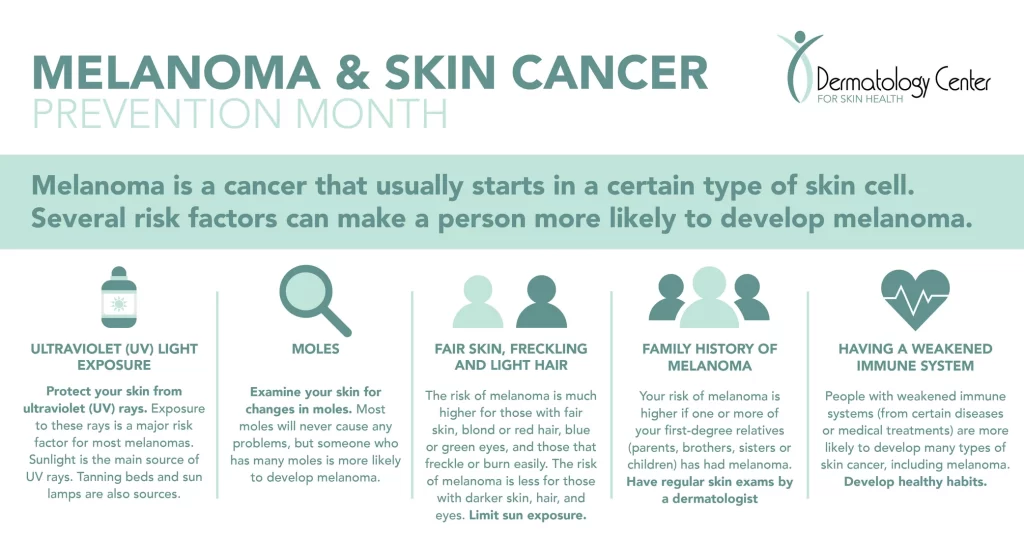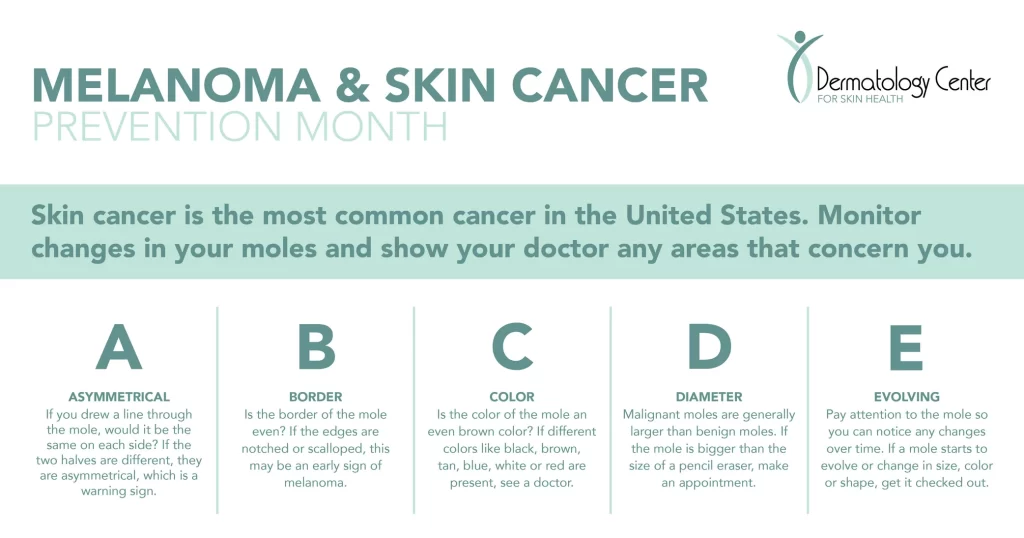The American Cancer Society estimates in 2018 there will be close to 100,000 cases of melanoma diagnosed, and around 10,000 of those cases will result in death.
Melanoma is the deadliest form of skin cancer; however, prevention and early detection are key in the successful inhibition and treatment of melanoma.
Read on to learn more about what melanoma is, how it can be identified, forms of treatment, prevention and more.
WHAT IS MELANOMA?
Melanoma is a form of skin cancer that generally starts in the melanocytes skin cell, which is the cell that controls pigmentation.
Melanoma can look different depending on whether the cells still produce melanin. If the cell continues making melanin, the melanoma tumor will look brown or black; however, if the cells are no longer making melanin, the tumor can appear pink, tan or white.
Although melanoma is the most severe form of skin cancer, it is not the only one. Click here to learn about different forms of skin cancer.
WHAT ARE MELANOMA SYMPTOMS?
Most of the time, moles, brown spots and other skin spots are usually harmless, but, unfortunately, this is not always the case.
Look out for warning signs such as:
- An additional mole you’ve never seen before
- A new dark spot on your skin
- A mole that has increased in size or changed shape
- Or any change in coloration on the skin
Any of these changes can be cause for concern, and you should seek medical advice. These lesions can occur anywhere on the body. For males, early signs of melanoma can appear on the chest and back. For females, signs begin on the legs.

TREATMENT FOR MELANOMA
Treatment, depending on how early it is caught, can range from a simple surgery to radiation treatments such as:
- Immunotherapy: the use of the immune system to help treat cancer by stimulating your own immune system or introducing man-made immune system proteins.
- Targeted therapy: a form of chemotherapy that targets cancer cells based on the differences between cancerous cells and normal cells. Most of the time, it is used along with other forms of cancer treatment.
- Chemotherapy: treatment of disease by the use of chemical substances such as cytotoxic and other drugs. This allows for the ability to kill not just cancer cells in the tumorous area but the whole body.
In the early stages of melanoma, surgery can be a recommended procedure. The most common surgery is an excision where the cancerous lesion is removed, the specimen is check by a dermatopathologist, and the borders are confirmed to be clear of cancer cells.
In severe cases, radiation therapy is used to kill abnormal cells. Sometimes more than one treatment method might be used to ensure the cancerous cells are removed.
HOW TO PREVENT MELANOMA?
There are many ways you can help prevent and lower your risk of all skin cancers.
Most forms of skin cancer, including melanoma, are caused by too much exposure to ultraviolet (UV) rays, with most exposure coming from the sun. You should wear sunscreen or sunblock and limit your time in direct sunlight. To learn what the differences are between sunscreen and sunblock, click here.
MELANOMA SELF-EXAMINATION | STEPS TO SELF-CHECK FOR MELANOMA
Doing a self-check for melanoma is simple and easy. Make sure you are in a well lit room with a mirror. You will also need a smaller mirror to exam difficult to see areas. Here are five short steps to help you with your self-examination:
- Check your face, neck and upper torso. Take extra time to look at your nose, lips, mouth and ears.
- Then, look over your arms. Make sure to check the whole arm starting by your armpit and moving down to your fingers.
- Next, examine the lower half of your torso, including the genital region.
- Check all of your legs all the way down to your toes.
- Finally make sure to look at the back of your body using the smaller mirror, or alternatively, you could have someone else help you.
If after executing a self-examination, you notice one of the above signs, you should schedule a visit with your dermatologist.
Please note, if you’re using a skin cancer check app, understand that it can not compare to visiting a trained MD.
Know ABCDE

HEAR FROM ONE OF OUR PATIENTS ABOUT HER MELANOMA JOURNEY
Donna Ricciuti is one of our patients who was diagnosed with melanoma. Through the great work of Dr. Maouad and early detection, Donna was able to receive surgery and overcome melanoma.
Schedule routine exams, like Donna, with your dermatologist to increase your chances of early detection and successful treatment.
MELANOMA AWARENESS MONTH
May is Melanoma Awareness Month. Thousands suffer from melanoma every year, and lives are lost. Throughout the month, remember to be aware of the warning signs and ways of prevention highlighted above.
During the month, help educate and inform others to raise awareness of the importance of preventing melanoma. All of the infographics in this blog will be shared to our social media; please feel free to share!
DERMATOLOGY CENTER FOR SKIN HEALTH, PLLC | SKIN CANCER PREVENTION
At the Dermatology Center for Skin Health, PLLC, our primary goal is to help our patients develop lifelong skin care habits that keep them cancer-free. We develop positive relationships with our patients, making annual skin checks a comfortable experience.
To schedule a skin cancer check, click below:



